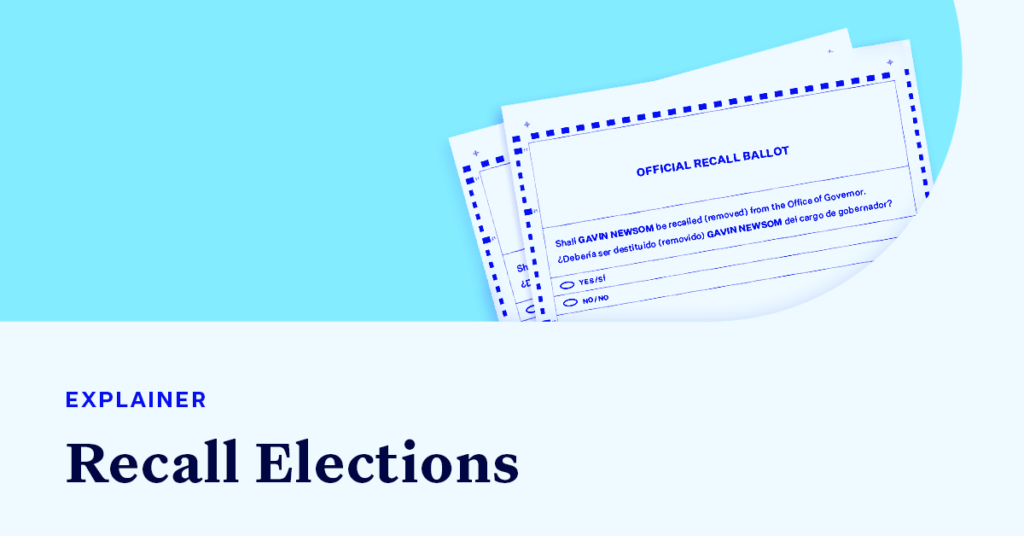What Is a Recall Election?

In the last few months, you’ve probably heard of a recall election in California. An improbable campaign by a host of Republican politicians, activists and yes, celebrities, has turned into a legitimate challenge to Gov. Gavin Newsom (D). But why is the incumbent governor facing an election before the end of his term? In today’s Explainer, we’re here to answer some major questions about recall elections — how and why they occur, how this increasing trend can undermine the will of the majority and importantly and what the stakes are in the biggest state in the nation this September.
How do you trigger a recall election?
A recall election is a process that allows voters to remove an elected official before the regularly scheduled election at the end of their term. In 39 states, various officials can be subject to recalls, although how easy it is to prompt a recall and what happens next varies significantly among states. And 12 of these 39 states require a stated reason for a recall, whether legal or political. For the rest, if the requisite amount of support is gathered for a recall election, it can be called for any reason.
There are hundreds of recall efforts every year, ranging from school board to governorship recall elections. However, most of these efforts do not reach their required legal minimum number of signatures in order to successfully warrant an election. Parties interested in recalling an elected official must gather a certain number of signatures within a matter of months, ranging from 10% to 40% of all the votes cast in the last election to that office. The shortest timeline for this petition collection process is 60 days in Colorado, Idaho, Wisconsin and Nevada; the longest is 320 days in New Jersey.
If a recall effort successfully gathers the required amount of signatures within the allotted time frame, an election is called in which all voters, including those opposed to the recall effort, can vote. After the election, if the incumbent is indeed recalled, states have three different processes they use to appoint successors. In some states, the same ballot used to recall candidates is used to replace the official. In others, a second special election is called to vote for a replacement. And in five states, the successor is appointed instead of elected.
How often do recalls happen?
The use of recalls as a political tool has increased significantly over recent years, and the last 10 years have seen the most recall efforts of any decade in U.S. history. California has attempted to recall its governor 55 times since its founding in 1913 — even though there have only been 40 governors. But recall efforts and recall elections are very different, and the vast majority of the hundreds of recall efforts in American history fizzle out. Only five governors have ever had a recall effort against them lead to an actual election, including the upcoming California contest. And, only two incumbent governors have lost that recall election.
In recent years, Republicans have embraced recall efforts more than Democrats. This calculus is based on history and on a changing political landscape: The most high-profile recall election in recent decades was won by Republicans, who successfully replaced Democratic California Gov. Gray Davis with Arnold Schwarzenegger in 2003. Recalls are a convenient tactic for a party who has seen its support significantly decline in Western states over the last few decades, as it allows for a do over after losing the popular vote in a regular election. Democrats have had less luck with recall elections: In 2012, Wisconsin Democrats unsuccessfully attempted to recall Gov. Scott Walker (R), who instead maintained his seat and used his increased national presence to launch his run for president.
What do I need to know about California’s recall election?
Although California voters are used to high numbers of failed recall efforts, this year’s effort has made it all the way to the ballot. Newsom faces a recall election on Sept. 14, 2021, despite winning the governorship by a landslide in 2018. Spurred by Newsom’s pandemic restrictions and partisan rage, Republicans successfully got Newsom on the ballot, and the race looks close. 46 other candidates are running to succeed Newsom, and one of them will be selected on the same ballot as him. Republican candidates include celebrity Caitlyn Jenner, Newsom’s 2018 opponent John Cox, conservative talk radio host Larry Elder and dozens of others. Under the rules of a recall, it’s possible that one of these candidates could replace Newsom with only a small plurality of the vote. Notably, Newsom won his 2018 election with a landslide 62% of the vote.
It’s vital that Democrats in the Golden State take this election seriously — and take action in the final days before Sept. 14. The governorship of the most populous state in the country is on the line, and there are ways you can help ensure that California stays blue. If you’re in California, sign up to volunteer and talk to your friends and neighbors about the recall. Remind them to send back their ballots and to vote NO on Question 1. Visit stoptherepublicanrecall.com to find the best way you can help out from wherever you are.
Republicans have a strong history of using recall elections to undermine the will of the majority of voters. Let’s make sure this September’s California election is not a repeat of history.